


In the popular press, final salary – also known as defined benefit – pensions are often referred to as ‘gold-plated’, the implication being that they are superior to defined contribution.
Many individuals, and a significant proportion of the adviser community, can dismiss the notion of doing anything with a DB pension other than keeping the annual benefit statements safe and waiting until the scheme retirement age. For many people, there is nothing wrong with this, and the DB pension will provide a solid foundation of index-linked income in retirement, free from any headaches about fund performance, the need for annual adviser reviews or concerns about market volatility.
However, for a significant number of people, with particular goals, personal circumstances and appropriate attitude to risk, a transfer away from a DB pension to a DC arrangement can be an extremely beneficial exercise. Here we recap on what aspects of a clients’ situation merit a fresh look at their DB arrangements and a discussion about their alternatives.
It is estimated that there are 6,070 DB schemes in the UK, comprising 11.1m members, and with assets of around £1trillion. Clearly this is a significant portion of the retirement market, and even if only a small subset would ultimately benefit from a transfer away from their existing DB arrangement, this represents a sizeable advice opportunity, especially in the light of the new pension freedoms from April 2015.
The starting point will be to apply for the cash equivalent transfer value of the members’ benefits. This figure is calculated by the actuary, representing a capitalised value of the sum needed by the member to buy the equivalent benefits in the open market at the scheme retirement age, discounted back to the present day after making a number of assumptions around such factors as growth rate over time, gilt yields, and inflation. The scheme funding position will also influence how much the trustees feel they can afford to transfer out of the scheme without disadvantaging remaining members.
All of these factors combine to influence the value which the client could take from the scheme, and as such the transfer value can vary significantly in a short space of time. One client of my company was keen to transfer out, but the scheme would only offer £460,000 at the time, which was extremely low given their deferred benefits.We revisited the case a year later when the transfer value offered had risen to over £820,000, allowing us to recommend a transfer. This is an extreme example but by no means unique.



